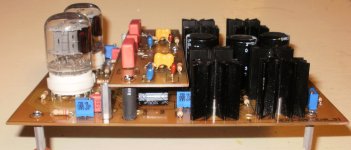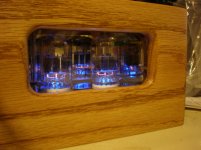Hello ruffrecords
I wish to build this amplifier,
But I have a helmet Grado sr60 impedance 32 ohms.
Work you he(it) with no problem at all or is it necessary to make modifications?
Cordially
Unfortunately this headphone amplifier design will not work with 32 ohm headphones. For Grado headphones you really need a transformer output to properly match the impedance. Here is a link to my headphones amp design which does this. It will drive any headphone from 600 ohms to 32 ohms impedance with very low distortion. The circuit is very similar to the one at the start of this thread but I have made several improvements.
http://www.diyaudio.com/forums/tubes-valves/191632-improved-tube-headphones-amp.html
Cheers
Ian
I built this one:
HeadWize - Project: The 6N1P OTL Headphone Amplifier by Bruce Bender
As it was too loud on my Senheiser cans (don't remember the model now) I put a feedback like here
http://digilander.libero.it/mqc69/OTL-1.htm
I was preparing to buy some Grado's, should I reconsider it?
Thanks
HeadWize - Project: The 6N1P OTL Headphone Amplifier by Bruce Bender
As it was too loud on my Senheiser cans (don't remember the model now) I put a feedback like here
http://digilander.libero.it/mqc69/OTL-1.htm
I was preparing to buy some Grado's, should I reconsider it?
Thanks
I built this one:
HeadWize - Project: The 6N1P OTL Headphone Amplifier by Bruce Bender
As it was too loud on my Senheiser cans (don't remember the model now) I put a feedback like here
http://digilander.libero.it/mqc69/OTL-1.htm
I was preparing to buy some Grado's, should I reconsider it?
Thanks
These two OTL headphone amps use a White follower output stage. That is good as it is push pull and has a very low output impedance. However, the lowest impedance phones it was tested with were 64 ohms and the particular phones used, Sony V6, have a very high sensitivity of 106dB/mW so they would need very little power.
If the Grado's are 32 ohms then I would say definitely no, it is not an option. Also, the 6N1P is a smaller tube than the ECC99 so it has a lower dissipation limit which means you have to run it at a lower current. However, for low impedance phones what you need is more current not less.
Cheers
Ian
I cheated, tube mosfet hybrid, tube front end and mosfet follower for low output impedance. I guess that you could say it is quite similar to the 6N1P-6N6P design but with a low impedance follower output. It can drive a small 8ohm speaker when biased higher than needed for headphones...
The input gain stage stage drives a tone section that feeds the SRPP with the class A follower output. Minimal feedback is used from the capacitor coupled outputs. The tone section is the little PCB that sits between the tubes and heat sinks. 1/2 height heat sinks are adequate for headphones, full height are needed when biased up for small speakers. Works for all headphones tested down to 32 ohms.
Some folks balk at sand in the signal path so I have another all tube design for this winter using 6JT8 tubes in a PP configuration with small Merit PP output transformers. It should be capable of 3-4watts/channel so driving headphones should not be an issue. If this design does not sound better than the hybrid, SE would be the next project. The hybrid is quite good so it has set the chin bar quite high to compare the other designs too.
The input gain stage stage drives a tone section that feeds the SRPP with the class A follower output. Minimal feedback is used from the capacitor coupled outputs. The tone section is the little PCB that sits between the tubes and heat sinks. 1/2 height heat sinks are adequate for headphones, full height are needed when biased up for small speakers. Works for all headphones tested down to 32 ohms.
Some folks balk at sand in the signal path so I have another all tube design for this winter using 6JT8 tubes in a PP configuration with small Merit PP output transformers. It should be capable of 3-4watts/channel so driving headphones should not be an issue. If this design does not sound better than the hybrid, SE would be the next project. The hybrid is quite good so it has set the chin bar quite high to compare the other designs too.
Attachments
I cheated, tube mosfet hybrid, tube front end and mosfet follower for low output impedance. I guess that you could say it is quite similar to the 6N1P-6N6P design but with a low impedance follower output. It can drive a small 8ohm speaker when biased higher than needed for headphones...
I have said this many times before but it is worth repeating. Low output impedance does not necessarily mean high drive capability. The OTL amplifiers being discussed already have a very low output impedance but they do not have a very high drive capability. High drive capability comes from a high standing current which is much easier to achieve with an FET than a tube.
Cheers
Ian
Yes, grado's are all 32 ohms, so I should search for something else. Do you have any suggestion? I know V6 are monitor headphones, are those ok? I listen mainly jazz and classical music. Thank you
I would say look for something with an impedance of at least 200 ohms. My personal favourites are Beyer DT250
Cheers
Ian
What about DT770/250ohm? I read only good things about them.
I have not tried them but nearly all Beyer headphones are pretty good.
Cheers
Ian
Hello,
Why do we call the output stage of this amplifier a SRPP. With the output connected to the bottom series triode there is no pushing or pulling going on. It is the input stage of the Aikido. Sometimes we call this half mu. The earliest place that I recall seeing this series triode arrangement is in the 1946 MIT Radiation laboratory series Vol 18 I recall. That text is careful to distinguish it from the version (now called SRPP) where the output is connected to the top triode cathode.
What is up with that?
DT
Why do we call the output stage of this amplifier a SRPP. With the output connected to the bottom series triode there is no pushing or pulling going on. It is the input stage of the Aikido. Sometimes we call this half mu. The earliest place that I recall seeing this series triode arrangement is in the 1946 MIT Radiation laboratory series Vol 18 I recall. That text is careful to distinguish it from the version (now called SRPP) where the output is connected to the top triode cathode.
What is up with that?
DT
Hello,
Why do we call the output stage of this amplifier a SRPP. With the output connected to the bottom series triode there is no pushing or pulling going on. It is the input stage of the Aikido. Sometimes we call this half mu. The earliest place that I recall seeing this series triode arrangement is in the 1946 MIT Radiation laboratory series Vol 18 I recall. That text is careful to distinguish it from the version (now called SRPP) where the output is connected to the top triode cathode.
What is up with that?
DT
You are quite right. I had not noticed the output is taken from the bottom anode. This, as drawn, is not an SRPP. I suspect the author made a mistake in the schematic and meant to take the output from the top cathode.
Cheers
Ian
Yes, grado's are all 32 ohms, so I should search for something else. Do you have any suggestion? I know V6 are monitor headphones, are those ok? I listen mainly jazz and classical music. Thank you
I tried a 6N6 WCF 6N6 OTL (Shiit) with Grado 32 ohm's SR60 and despite what I expect they works fine!
5687/ 6N6 White catode follower can deserve a try also with low resistance (but high sensitivity) headphones.
- Status
- This old topic is closed. If you want to reopen this topic, contact a moderator using the "Report Post" button.
- Home
- Amplifiers
- Tubes / Valves
- 6N1P and 6N6P OTL headphone amp


